Intel Moves Closer to 45nm Penryn Processor Production
Intel’s 45nm Family of Penryn Processors
Intel has been able to nail down their high-k + metal gate transistor technology and the next generation dual-core and quad-core processors will have the new transistors. The first processor family to use this new technology will be Penryn, which is the next generation Intel Core 2 processor.
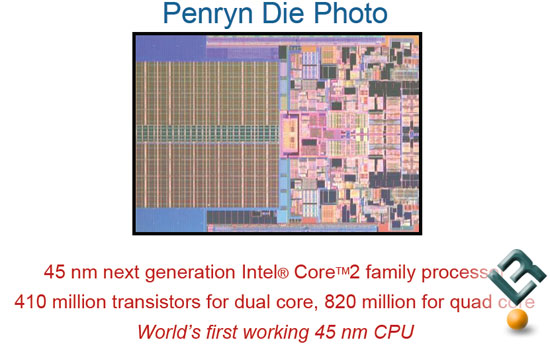
When we reviewed Intel’s Core 2 Duo processor we were amazed by how it contained 291 million transistors, but that is nothing compared to the 410 million transistors found on the dual-core Penryn die. A quad-core processor will have a pair of these dies and thus have 820 million transistors on a single LGA775 processor. Thanks to the high-k + metal gate technology the 45nm part will benefit from clock rate improvements at the same thermal envelope that current Core 2 processors have. Rumor has it that Intel will be launching Penryn processors with clock frequencies well over 3GHz. In addition to the increased frequency Intel is also planning on adding cache and we suspect the bulk of the additional 119 million transistors will be dedicated to the increased cache. As if higher clock rates and more cache isn’t enough Intel also has added SSE4 instructions that are said to greatly help in some integer and floating point operations.
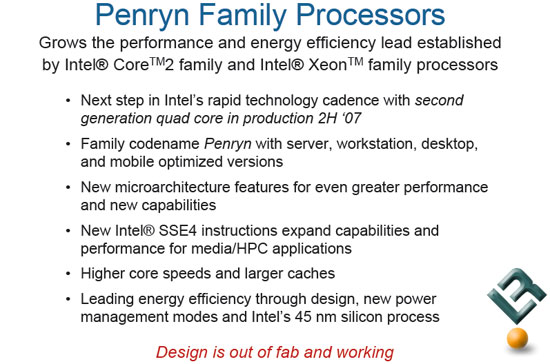
Intel had select press out to visit yesterday where they had five systems up and running Penryn series processors on mobile, desktop and server systems. Intel plans on rolling out processors for all three of these platforms in the second half of 2007. There was no mention of quad-core mobile processors, but 45nm dual-core mobile parts are on the way this year. The five working systems were configured as the following:
-
Unknown frequency 45nm dual-core mobile processor in a notebook with Microsoft Vista running Microsoft Office 2003 applications
-
2.13GHz 45nm dual-core desktop processor running high definition video content (1080P) under Microsoft Vista.
-
1.86GHz 45nm quad-core desktop processor running Ubisoft’s Rainbow Six Las Vegas game under Microsoft Vista
-
Two, 2.13GHz 45nm dual-core processors running Glaze Workstation application under Microsoft Windows 2000 Advanced Server
-
Two, 2.13GHz 45nm quad-core processors encoding a video in Adobe Premier under Microsoft Vista
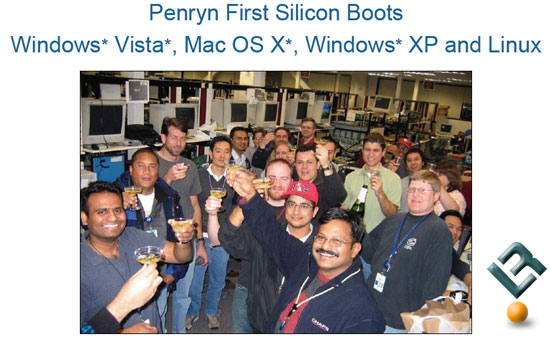
Intel has had working Penryn samples since November 2006, but just recently booted a vast number of operating systems. Intel provided the above picture of the Penryn group the night the first Silicon booted Windows XP up at D1D in Oregon.
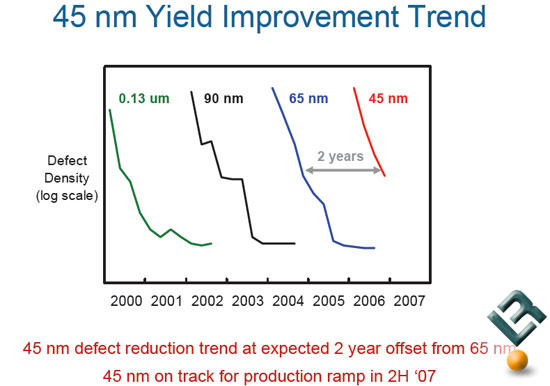
As previously mentioned Intel is on track for getting 45nm parts out in mass during the second half of this year and if all goes as planned it won’t be too long for 32nm lithography begins!
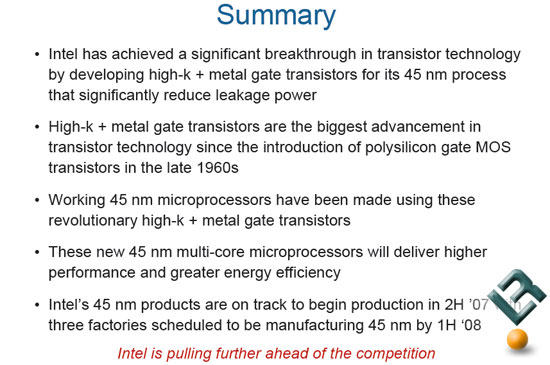
To sum it all up the high-k + metal gate transistor breakthrough has paved the way for 45nm processors to enter mass production and laid the ground work for improved performance. Intel seems to be running ahead of schedule with 45nm and it wouldn’t be shocking if they pulled in the release of the microprocessors to try and steal some thunder from AMD and their upcoming K8L processor line that has been kept quiet. The rumor mill around Intel’s upcoming parts has been running wild the past year and it continues to this day. The most recent rumor is that Penryn processors will bring back Hyper-Threading. Intel public relations had this to say when asked about HT and Penryn: ‘It’s a technology we pioneered for mainstream computers and we’ve left the door open to bring it back, but are not going to speculate at this time.’ While the answer isn’t really direct it does give some insight into what Intel might be up to in the future. If one was to ask Intel if DDR1 memory was coming back, I’m not sure they would have replied with the door was left open. Legit Reviews also asked Intel about what chipsets support Penryn and if current motherboard would work and they again declined to directly answer the question and only said that minor BIOS and electrical changes would be needed and that Intel couldn’t say that one of today’s boards would work for sure. With upcoming enthusiast chipsets like X38/ICH9 one could only guess that enthusiasts would want a chipset upgrade anyway, so does it really matter?

Comments are closed.